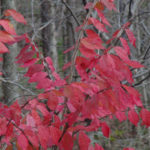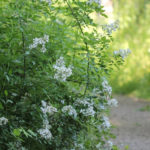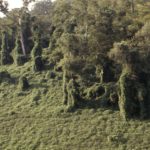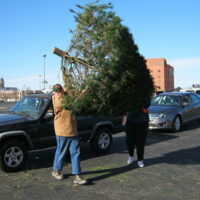 Purdue University - Extension - Forestry and Natural Resources
Purdue University - Extension - Forestry and Natural Resources
Got Nature? Blog
Purdue Landscape Report: April showers bring May Flowers. Many of us were taught this little rhyme to describe the weather of Spring. April has arrived along with the beginning of the Spring storm season and damage to and from trees is a topic of concern on many minds. Depending on the intensity of the storms and the condition of the trees, damage from high winds, heavy rainfall, and lightning can be quite severe. Cracked or broken branches, stem failure, and root failure are some of the main concerns, but also the risk and liability of damage to people and property.

Storm season is upon us. There are a number of resources from Purdue to help dealing with storm-damaged trees.
If your tree is damaged, there are some steps to deal with the situation. First and foremost, consider the safety of yourself and others around you. Inspect the tree from a distance first, looking for the following:
- Heaving of the ground, indicating potential root failure
- Damage to limbs and/or the trunk of the tree
- Hanging branches can fall to the ground, resulting in injury or death
- Be aware of utility and power lines. Trees can become charged by coming in contact with live wires. All utility lines should be considered energized and dangerous.
If you find your trees damaged from a storm hiring an International Society of Arboriculture (ISA) Certified Arborist to perform a risk assessment will help guide your decision of how to manage your tree. To find an arborist near you and verify credentials, use the link at Find an Arborist, Trees are Good, International Society of Arboriculture (ISA). For more information, you can also view the publication Trees and Storms, located in The Education Store, Purdue Extension’s resource center.
Subscribe and receive the newsletter: Purdue Landscape Report Newsletter.
Resources:
Find an Arborist video, Trees are Good-International Society of Arboriculture (ISA)
Trees and Storms – The Education Store, Purdue Education’s resource center
Caring for storm-damaged trees/How to Acidify Soil in the Yard – In the Grow, Purdue Extension
Why Is My Tree Dying? – The Education Store
Tree Risk Management – The Education Store
Mechanical Damage to Trees: Mowing and Maintenance Equipment – The Education Store
Trees and Electric Lines – The Education Store
Tree Defect Identification, The Education Store
Planting Your Tree, video, The Education Store
Tree Installation, The Education Store
Tree Wound and Healing, Got Nature? Blog, Purdue Extension – Forestry and Natural Resources
Ask an Expert: Tree Selection and Planting, Purdue Extension – Forestry and Natural Resources (FNR) YouTube Channel
Tree Pruning Essentials, Purdue Extension – FNR YouTube Channel
Subscribe – Purdue Extension-FNR YouTube Channel
Ben McCallister, Urban Forestry Specialist
Purdue Forestry & Natural Resources
Hummingbirds are a popular attraction in any backyard and we receive questions on when they will be coming to Indiana and how to attract them to your backyard. Our Purdue professor emeritus of wildlife ecology Barny Dunning in this interview for CBS4 Indianapolis titled “How to attract hummingbirds during peak migration,” shares how planting a variety of plants that bloom will help draw them in along with a simple hummingbird mixture.
The ruby-throated hummingbird is the only species of hummingbird that nests in the Hoosier state. These colorful visitors are migratory and arrive from their wintering grounds around mid-April.
Dr. Brian MacGowan has a publication titled Attracting Hummingbirds to Your Yard that is a great resource to share along with this video showing how to prepare your hummingbird feeders and how to find out when they will be migrating to your area. Hummingbird Central also tracks spring and fall migrations. Anyone can submit sightings on their website and view up-to-date sightings.
Resources:
Attracting Hummingbirds to Your Yard publication, The Education Store-Purdue Extension resource center
Virtual Tour Brings Forest Management for Birds to Life, Got Nature? Blog, Purdue Extension FNR
Birding Through the Seasons, Indiana Forestry & Woodland owners Association (IFWOA)
Behold! The Atlas of Breeding Birds of Indiana, MyDNR, Indiana Department of Natural Resources, Got Nature? Blog, Purdue Extension FNR
Breeding Birds and Forest Management: the Hardwood Ecosystem Experiment and the Central Hardwoods Region, The Education Store, Purdue Extension – Forestry and Natural Resources
Forest Birds, The Education Store
Managing Woodlands for Birds, The Education Store
Managing Woodlands for Birds Video, Purdue Extension-Forestry and Natural Resources (FNR) YouTube Channel
The Birders’ Dozen, Profile: Baltimore Oriole, Indiana Woodland Steward
Birds and Residential Window Strikes: Tips for Prevention, The Education Store, Purdue Extension resource center
No Room at the Inn: Suburban Backyards and Migratory Birds, Education Store
Question: Is there any risk of becoming infected with avian influenza virus by feeding backyard birds?, Got Nature? Blog, Purdue Extension FNR
Preventing Wildlife Damage – Do You Need a Permit?, The Education Store
How to Construct a Scent Station video, The Education Store
Question: How do I properly relocate raccoons from my attic?, Got Nature? Blog, Purdue Extension FNR
Nuisance Wildlife, Indiana Department of Natural Resources
Subscribe – Purdue Extension-FNR YouTube Channel
Brian MacGowan, Wildlife Extension Specialist
Purdue Forestry and Natural Resources
 Join David and Mary Ray on a tour of their award winning forest in southwest Jackson County! The Rays are hands-on managers of their beautiful southern Indiana oak forest, and are excited to share the results of their management strategies with you!
Join David and Mary Ray on a tour of their award winning forest in southwest Jackson County! The Rays are hands-on managers of their beautiful southern Indiana oak forest, and are excited to share the results of their management strategies with you!
Registration is required for this FREE EVENT. To register call or email Let the Sun Shine In – Indiana, Judi Brown, coordinator, 812-631-4904, JBrown@abcbirds.org. Registration is due April 3rd. Please share any dietary restrictions if needed.
Date: April 5, 2025
Time: 9:30am to 1:00pm EDT
Location: David & Mary Ray Property, Southwest Jackson County, 5 miles SW of Medora, event signs will be posted
Schedule:
Onsite Registration: 9:00 AM
Forestry Tour: 9:30 to Noon
Lunch: 12 to 1 PM, sponsored by Indiana Forestry and Woodland Owners Association (IFWOA)
Maple Sap Gathering 1 PM, optional
Speakers Include:
David Ray, Property Owner
Dan McGuckin, ACF, CF, CWB
Dan Shaver, NRCS State Forester
Judi Brown, LSSI IN
Take note: This is a walking tour in a hilly forest. Be prepared for rough terrain; please wear appropriate clothing and footwear. Limited on-site transportation assistance available, if needed. In the event of storm rain date is April 12, 2025.
To print flyer and view large map visit: Indiana Forestry & Woodlands Owners Association (IFWOA): Oak Management Forestry Field Day: Jackson County flyer (pdf).
For all IFWOA events and woodland resources view Indiana Forestry & Woodlands Owners Association (IFWOA) website.
Resources:
Indiana Forestry & Woodland Owners Association (IFWOA) YouTube Channel
Deer Impact Toolbox, Purdue Extension Pond and Wildlife Management
District Forester, Indiana DNR Division of Forestry, for over 10 acres of woodlands
Directory of Professional Foresters, Indiana Forestry & Woodland Owners Association (IFWOA)
Indiana Woodland Steward E-newsletters, Eleven Member Organization
A Woodland Management Moment, Playlist, Purdue Extension – Forestry and Natural Resources (FNR) YouTube Channel
Conservation Tree Planting: Steps to Success, Purdue Extension – FNR YouTube Channel
Forest Improvement Handbook, The Education Store
Invasive Species, Playlist, Purdue Extension – FNR YouTube Channel
Woodland Stewardship for Landowners, Playlist, Purdue Extension – FNR YouTube Channel
Invasive Plant Species Identification, Video, Purdue Extension – FNR YouTube Channel
Report Invasive Species, Purdue Invasive Species
ID That Tree – Video Playlist, Purdue Extension – Forestry and Natural Resources (FNR) YouTube Channel
Subscribe – Purdue Extension-FNR YouTube Channel
Liz Jackson, IFWOA engagement specialist & Walnut Council Manager
Indiana Forestry & Woodlands Owners Association (IFWOA)
 A Directory of Professional Foresters is now available, listing Indiana foresters who provide private woodland services and advice. Foresters are located throughout the state and provide assistance such as management plans, timber sales, tree planting, invasive species control, and many other services.
A Directory of Professional Foresters is now available, listing Indiana foresters who provide private woodland services and advice. Foresters are located throughout the state and provide assistance such as management plans, timber sales, tree planting, invasive species control, and many other services.
“Finding the resources to help you meet your woodland management objectives is important to successful stewardship,” says Liz Jackson, Purdue Extension and manager of Indiana Forestry & Woodland Owners Association. “Professional foresters can provide expert assistance to meet your property management goals.”
The Directory is available online via interactive map at www.findindianaforester.org to find foresters by location, or as a downloadable document. Printed copies of the booklet are available at County Extension and Soil & Water Conservation District offices or through a state Division of Forestry district forester.
Indiana Forestry & Woodland Owners Association promotes the wise use of Indiana’s forest resource for today and future generations. Learn more at www.ifwoa.org.
Resources:
Indiana Forestry & Woodland Owners Association (IFWOA) YouTube Channel
Deer Impact Toolbox, Purdue Extension Pond and Wildlife Management
District Forester, Indiana DNR Division of Forestry, for over 10 acres of woodlands
Directory of Professional Foresters, Indiana Forestry & Woodland Owners Association (IFWOA)
Indiana Woodland Steward E-newsletters, Eleven Member Organization
A Woodland Management Moment, Playlist, Purdue Extension – Forestry and Natural Resources (FNR) YouTube Channel
Conservation Tree Planting: Steps to Success, Purdue Extension – FNR YouTube Channel
Forest Improvement Handbook, The Education Store
Invasive Species, Playlist, Purdue Extension – FNR YouTube Channel
Woodland Stewardship for Landowners, Playlist, Purdue Extension – FNR YouTube Channel
Invasive Plant Species Identification, Video, Purdue Extension – FNR YouTube Channel
Report Invasive Species, Purdue Invasive Species
ID That Tree – Video Playlist, Purdue Extension – Forestry and Natural Resources (FNR) YouTube Channel
Subscribe – Purdue Extension-FNR YouTube Channel
Liz Jackson, IFWOA engagement specialist & Walnut Council Manager
Indiana Forestry & Woodlands Owners Association (IFWOA)
Morning AgClips — You have probably seen a cartoon or stereotypical TV show where someone sees a mouse and says, “Eek, a mouse!” Mice and rats around homes and farmsteads can be a problem. Have control methods improved on the typical snap trap of 50 years ago? In short, they have.
The adult house mouse is about 5½ to 7½ inches long, including the 3–4-inch tail. Norway rats are much larger, from 13 to 18 inches long, including the 6–8½-inch tail. According to the Internet Center for Wildlife Damage Management (ICWDM), mice eat many types of food but prefer seeds and grain. They sample new foods and are considered “nibblers.” Foods that are high in fat, protein, or sugar (e.g., bacon, chocolate, butter, nuts) may be preferred, even when grain and seeds are present. An individual mouse consumes about 1/10 of its body weight each day and up to 8 pounds per year. Mice contaminate far more food than they consume through their urine and feces.
In homes and commercial buildings, mice may feed on stored food items and pet foods. They contaminate food with their urine, droppings, and hair. On farms, they damage structures that store feed and equipment. Mice often act as reservoirs or vectors of diseases, such as swine dysentery, leptospirosis, salmonellosis, and other diseases.
ICWDM suggests several preventive and control methods people can employ. Proper sanitation around structures is helpful. This reduces sources of food, water, and shelter. Rodent-proof construction is recommended, along with proper storage and disposal of refuse and garbage. They indicate that ultrasonic frightening devices are generally not effective. Repellants and toxicants are options to consider. Trapping devices, such as snap traps, cage or box traps, and glue boards, may also be considered for use.
Read more details on the Morning AgClips website at Dealing with Rodents Around Homes & Farms.
Resources:
A Template for Your Wildlife Habitat Management Plan, The Education Store, Purdue Extension resource center
Wildlife Habitat Hint, Purdue Extension – Forestry & Natural Resources (FNR) YouTube Playlist
Woodland Stewardship for Landowners, Purdue Extension – FNR YouTube Playlist
Woodland Management Moment, Purdue Extension – FNR YouTube Playlist
Invasive Species, Playlist, Purdue Extension – FNR Youtube Channel
Invasive Plant Species Identification, Video, Purdue Extension – FNR Youtube Channel
Invasive plants: impact on environment and people, The Education Store, Purdue Extension’s resource center
Woodland Invaders, Got Nature? Blog, Purdue Extension – FNR
Preventing Wildlife Damage – Do You Need a Permit? – The Education Store, Purdue Extension resource center
Selecting a Nuisance Wildlife Control Professional, The Education Store
How to Construct a Scent Station, The Education Store
Question: How do I properly relocate raccoons from my attic?, Got Nature? Blog, Purdue Extension FNR
Nuisance Wildlife – Indiana Department of Natural Resources
Subscribe to our FNR Extension YouTube Channel with over 250 videos which include: aquatic, forestry, urban forestry, wildlife, community planning videos and much more.
John E. Woodmansee, Extension Educator – Agriculture and Natural Resources (ANR)
Purdue Extension – Whitely County
Invasive species are any plant, animal, insect or plant disease not native to a specific location that can cause harm to the environment, impact the diversity of native species, reduce wildlife habitat or disrupt important ecosystem functions.
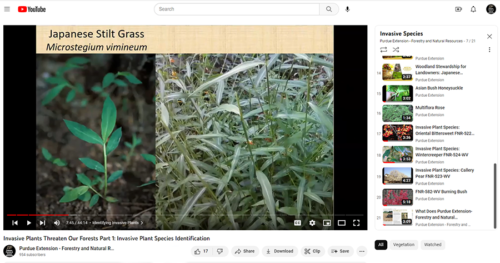 Why should you care about invasive species? Invasive species limit land use, degrade natural resources and inhibit recreational pursuits such as hunting, fishing, bird watching, and foraging. They also negatively impact fisheries, agricultural and forestry industries, destabilize soil and alter water resources. Invasive species also out compete natives and are costly to control with estimates showing that the U.S. spends $137 billion/year to control/manage invasive species.
Why should you care about invasive species? Invasive species limit land use, degrade natural resources and inhibit recreational pursuits such as hunting, fishing, bird watching, and foraging. They also negatively impact fisheries, agricultural and forestry industries, destabilize soil and alter water resources. Invasive species also out compete natives and are costly to control with estimates showing that the U.S. spends $137 billion/year to control/manage invasive species.
As spring approaches, many invasive plants will begin to leaf out in woodland areas. Spring is a good time to stop them in their tracks so they don’t overtake native plants, affect water availability or damage the quality of soil among other potential impacts.
Here are some resources to help you identify various invasive plants in woodland areas near you, to know when to report them and also what you can do help control their spread.
Videos on Purdue Extension – Forestry and Natural Resources (FNR) YouTube Channel, Invasive Species Playlist
- Asian Bush Honeysuckle
- Burning Bush
- Callery Pear
- Multiflora Rose
- Invasive Plants Threaten Our Forests Part 1: Invasive Plant Species Identification
- Invasive Plants Threaten Our Forests Part 2: Control and Management
Don’t miss this YouTube Shorts video, Lenny Farlee Talks About Invasive Plants Emerging in Early Spring
More Purdue Extension-FNR YouTube Video Series –
Woodland Management Moment Videos:
Woodland Stewardship for Landowners Videos:
ID That Tree Videos:
- Invasive White Mulberry
- Invasive Siberian Elm
- Invasive Tree of Heaven
- Invasive Amur Honeysuckle
- Asian Honeysuckle
FNR Extension Publications, The Education Store:
- Invasive Plant Species: Oriental Bittersweet
- Invasive Plant Species: Wintercreeper
- Japanese Chaff Flower
- Kudzu in Indiana
- Mile-a-minute Vine
Purdue Landscape Report:
- Alternatives to Burning Bush for Fall Color
- Now is the Time to Identify Callery Pear
- Keyword search: Invasive
FNR Extension Got Nature? Blog:
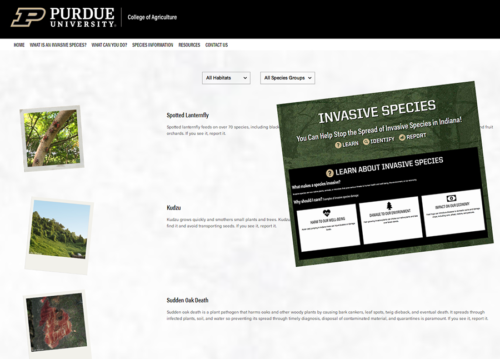 When and how do I report an invasive species?
When and how do I report an invasive species?
The Purdue Invasive Species website will help you identify invasive species and explain how to send in your findings. If you notice something is killing an otherwise healthy stand of trees or shrubs, you will want to identify it and report it if it is on the invasive list. If you see a plant that is taking over an area where it doesn’t belong, you will want to identify it and report it if it is on the invasive list.
- The GLEDN Phone App – Great Lakes Early Detection Network
- EDDMaps – Early Detection and Distribution Mapping System
- 1-866 No EXOTIC (1-866-663-9684)
- depp@dnr.IN.gov – Email Indiana Department of Natural Resources (DNR)
More Resources
Indiana Department of Natural Resources: Invasive Species
Indiana Invasive Species Council
Cooperative Invasive Species Management Area (CISMA)
Aquatic Invasive Species, Illinois-Indiana Sea Grant (IISG)
Episode 11 – Exploring the challenges of Invasive Species, Habitat University-Natural Resource University
Emerald Ash Borer Information Network, Purdue University and Partners
What Nurseries Need to Know About the Invasive Species Regulation, The Education Store, Purdue Extension’s resource center
Invasive plants: impact on environment and people, The Education Store, Purdue Extension’s resource center
Diana Evans, Extension and Web Communication Specialist
Purdue University Department of Forestry and Natural Resources
Lenny Farlee, Extension Forester
Hardwood Tree Improvement and Regeneration Center
Purdue Department of Forestry & Natural Resources
Wild Bulletin, Indiana Department of Natural Resources (DNR) Fish and Wildlife: Have you seen wildlife showing odd behaviors or signs of disease? DNR encourages you to report them using our online Sick or Dead Wildlife report system. DNR is especially interested in recurring deaths of wildlife in the same location over a period of time, deer showing signs that may indicate chronic wasting disease or epizootic hemorrhagic disease, or incidents involving threatened or endangered species.
Indiana DNR’s Sick or Dead Wildlife Reporting System collects information about wildlife that appear sick or appear to have died without an apparent cause (e.g. do not use this form for predation or roadkill). Reports of incidents involving common species and single animals are useful to help us understand baseline levels of sickness and death in wildlife populations.
Your reports help us track wildlife health over time and detect potential disease outbreaks in the state. Visit the Sick or Dead Wildlife Reporting webpage to learn more.
Resources
Hardwood Ecosystem Experiment – Wildlife Responses to Timber Harvesting, video, Purdue Extension resource center
Forest Improvement Handbook, The Education Store
Invasive plants: impact on environment and people, The Education Store
Managing Your Woods for White-Tailed Deer, The Education Store
Breeding Birds and Forest Management: the Hardwood Ecosystem Experiment and the Central Hardwoods Region, The Education Store
Managing Woodlands for Birds Video, Purdue Extension-Forestry and Natural Resources YouTube Channel
Subscribe: Deer, Forest Management, Invasive Species and many other videos, Purdue Extension-Forestry and Natural Resources YouTube Channel
Indiana Department of Natural Resources – Division of Fish & Wildlife
Welcome to this edition of “ID That Tree”. In this video Purdue Extension forester Lenny Farlee will introduce you to leatherwood, a charming Indiana shrub. Typically found in the understory of forest areas, this compact shrub is easy to identify by its oblong leaves with smooth margins and alternate leaf arrangement. Join us to learn more about leatherwood and its unique characteristics!
If you have any questions regarding wildlife, trees, forest management, wood products, natural resource planning or other natural resource topics, feel free to contact us by using our Ask an Expert web page.
Resources:
ID That Tree – Video Playlist, Purdue Extension – Forestry and Natural Resources (FNR) YouTube Channel
Purdue Arboretum Explorer
Conservation Tree Planting: Steps to Success, Purdue Extension – FNR YouTube Channel
A Woodland Management Moment, Playlist, Purdue Extension – FNR YouTube Channel
Woodland Stewardship for Landowners, Playlist, Purdue Extension – FNR YouTube Channel
Indiana Department of Natural Resources: Invasive Species
Indiana Invasive Species Council
Cooperative Invasive Species Management Area (CISMA)
Report Invasive, Purdue Extension
101 Trees in Indiana, Amazon
Episode 11 – Exploring the challenges of Invasive Species, Habitat University-Natural Resource University
Shrubs and Woody Vines of Indiana and the Midwest, The Education Store
Native Trees of the Midwest, The Education Store
Professional Forester, Indiana Forestry Woodland Owners Association
Forest Improvement Handbook, The Education Store
Find an Arborist, International Society of Arboriculture
Lenny Farlee, Extension Forester
Hardwood Tree Improvement and Regeneration Center
Purdue Department of Forestry & Natural Resources
Tax preparation time usually brings with it questions about what is deductible, how to report this income and what you can do to save on your taxes in the future. Fortunately for woodland owners, there are several excellent resources available to help you find some guidance.
A national site addressing tax issues for woodland owners is the National Timber Tax Website. This site provides updated tax tips for the 2024 filing year, as well as many guides and references to help you effectively plan a tax strategy for your property.
The first link you will see on the National Timber Tax website is the recent timber tax tips by the U.S. Department of Agriculture (USDA), Forest Service:
Tax Tips for Forest Landowners: 2024 Tax Year (pdf 176KB)
Purdue Forestry and Natural Resources Extension offers some publications covering taxation issues for timber sales and tree planting.
How to Treat Timber Sale Income
Determining Tax Basis of Timber
Financial and Tax Aspects of Tree Planting
If you sold timber or planted trees for timber production last year, the references above may help you understand your options and possibly provide some tax savings.
Familiarizing yourself with the tax treatment of timber sales and tree plantings may help you more effectively plan for future tax returns.
Other resources:
U.S. Forest Service
Indiana Department of Natural Resources Offers Program Aiding in Property Tax Reductions, Purdue Extension – Forestry & Natural Resources (FNR) Blog Article
The Education Store, Purdue Extension (place in search field: “timber”)
Find an Indiana Professional Forester, Indiana Forestry & Woodland Owners Association (IFWOA)
Purdue Arboretum Explorer
Native Trees of the Midwest, The Education Store
Shrubs and Woody Vines of Indiana and the Midwest, The Education Store
Investing in Indiana Woodlands, The Education Store
Forest Improvement Handbook, The Education Store
ID That Tree, Purdue Extension-Forestry & Natural Resources (FNR) YouTube playlist
Woodland Management Moment , Purdue Extension-FNR YouTube playlist
Indiana DNR Offers Special Program Aiding in Property Tax Reductions – IFWOA
Lenny Farlee, Extension Forester
Hardwood Tree Improvement and Regeneration Center (HTIRC)
Forestry and Natural Resources, Purdue University
When do you need to discard your real Christmas tree? What options are there in disposing the tree?
Check out these tips from our Purdue experts:
Lenny Farlee, Purdue Extension Forester with Forestry and Natural Resources, in interview with the WLFI news team shares the first steps is to remove all decorations. “Several municipalities here in the area will either take the trees for mulching or composting. So if you don’t want to fool with the tree anymore, that’s a great option. You can just take it to the curb, or certain locations, and they’ll take care of it for you and it gets reused or recycled into usable material,” explains Farlee. Choosing to keep the tree in your backyard is a great wildlife friendly option. Lenny shares how important it is to remove your tree in a timely manner to avoid any fire hazards in your house. The video explains on how you can test your tree to see if it should be discarded. See video and full article for more options: Options for Getting Rid of Real Christmas Tree, wlfi.com.
John Woodmansee, Purdue Extension Educator-Agriculture Natural Resources (ANR), also shares tips in the Purdue Extension article Recycle Your Christmas Tree. If you have permission and/or have access to a private pond you can discard your tree in the pond to improve fish habitat.
Resources:
A Choose-and-Cut Pine and Fir Christmas Tree Case Study, The Education Store, Purdue Extension’s resource center
Living Christmas Trees For The Holidays and Beyond, The Education Store
Tips for First-Time Buyers of Real Christmas Trees, The Education Store
Growing Christmas Trees, The Education Store
Selecting an Indiana-Grown Christmas Tree, The Education Store
Repurposing Your Real Christmas Tree, Purdue Extension News
An Introduction to Trees of Indiana, The Education Store
Native Trees of the Midwest, The Education Store
Shrubs and Woody Vines of Indiana and the Midwest, The Education Store
ID That Tree, Playlist, Subscribe to Purdue Extension – Forestry and Natural Resources YouTube Channel
A Woodland Management Moment, Playlist, Purdue Extension – FNR YouTube Channel
Investing in Indiana Woodlands, The Education Store
Forest Improvement Handbook, The Education Store
Finding help from a professional forester, Indiana Forestry & Woodland Owners Association
District Foresters for 10 plus acres, Indiana Department of Natural Resources
Wood Products, FNR Concentration
Diana Evans, Extension & Web Communications Specialist
Purdue University Department of Forestry and Natural Resources
Lenny Farlee, Extension Forester
Hardwood Tree Improvement and Regeneration Center
Purdue Department of Forestry & Natural Resources
Recent Posts
- Tips to Manage Storm-Damaged Trees, Purdue Landscape Report
Posted: April 17, 2025 in Forests and Street Trees, How To, Urban Forestry - When is the Peak Migration For Hummingbirds and How Can You Attract Them?
Posted: April 4, 2025 in How To, Wildlife - Rays Sharing Their Award Winning Forest – Oak Management Forestry Field Day
Posted: March 20, 2025 in Forestry, How To, Invasive Plant Species, Wildlife, Woodlands - New Directory of Professional Foresters Now Available for Indiana Woodland Owners
Posted: March 19, 2025 in Forestry, How To, Woodlands - Dealing with Rodents Around Homes & Farms – Morning AgClips
Posted: March 1, 2025 in How To, Invasive Animal Species, Uncategorized - What Are Invasive Species and Why Should I Care?
Posted: February 24, 2025 in Forestry, How To, Invasive Plant Species, Plants, Woodlands - Report Sick/Dead Wildlife: Make a Difference – Wild Bulletin
Posted: February 18, 2025 in How To, Wildlife - ID That Tree: Shrubs Edition – Leatherwood
Posted: February 7, 2025 in Forests and Street Trees, How To, Urban Forestry, Woodlands - Tax Information For Woodland Owners
Posted: January 30, 2025 in Forestry, How To, Timber Marketing, Woodlands - Tips on How You Can Recycle Your Christmas Tree
Posted: December 16, 2024 in Ask the Expert, Christmas Trees, Forestry, Forests and Street Trees, How To, Wildlife
Archives
Categories
- Alert
- Aquaculture/Fish
- Aquatic/Aquaculture Resources
- Ask the Expert
- Christmas Trees
- Community Development
- Disease
- Drought
- Forestry
- Forests and Street Trees
- Gardening
- Got Nature for Kids
- Great Lakes
- How To
- Invasive Animal Species
- Invasive Insects
- Invasive Plant Species
- Land Use
- Natural Resource Planning
- Nature of Teaching
- Plants
- Podcasts
- Ponds
- Publication
- Safety
- Spiders
- Timber Marketing
- Uncategorized
- Urban Forestry
- Webinar
- Wildlife
- Wood Products/Manufacturing
- Woodland Management Moment
- Woodlands

